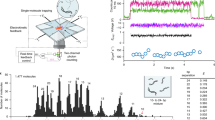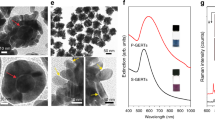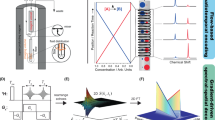Abstract
Nanoscale distance-dependent phenomena, such as Förster resonance energy transfer, are important interactions for use in sensing and imaging, but their versatility for bioimaging can be limited by undesirable photon interactions with the surrounding biological matrix, especially in in vivo systems1,2,3,4. Here, we report a new type of magnetism-based nanoscale distance-dependent phenomenon that can quantitatively and reversibly sense and image intra-/intermolecular interactions of biologically important targets. We introduce distance-dependent magnetic resonance tuning (MRET), which occurs between a paramagnetic ‘enhancer’ and a superparamagnetic ‘quencher’, where the T1 magnetic resonance imaging (MRI) signal is tuned ON or OFF depending on the separation distance between the quencher and the enhancer. With MRET, we demonstrate the principle of an MRI-based ruler for nanometre-scale distance measurement and the successful detection of both molecular interactions (for example, cleavage, binding, folding and unfolding) and biological targets in in vitro and in vivo systems. MRET can serve as a novel sensing principle to augment the exploration of a wide range of biological systems.
This is a preview of subscription content, access via your institution
Access options
Access Nature and 54 other Nature Portfolio journals
Get Nature+, our best-value online-access subscription
$29.99 / 30 days
cancel any time
Subscribe to this journal
Receive 12 print issues and online access
$259.00 per year
only $21.58 per issue
Buy this article
- Purchase on Springer Link
- Instant access to full article PDF
Prices may be subject to local taxes which are calculated during checkout




Similar content being viewed by others
References
Medintz, I. L., Uyeda, H. T., Goldman, E. R. & Mattoussi, H. Quantum dot bioconjugates for imaging, labelling and sensing. Nat. Mater. 4, 435–446 (2005).
Miyawaki, A. et al. Fluorescent indicators for Ca2+ based on green fluorescent proteins and calmodulin. Nature 388, 882–887 (1997).
Ntziachristos, V. Going deeper than microscopy: The optical imaging frontier in biology. Nat. Methods 7, 603–614 (2010).
Veiseh, O., Gunn, J. W. & Zhang, M. Design and fabrication of magnetic nanoparticles for targeted drug delivery and imaging. Adv. Drug Deliv. Rev. 62, 284–304 (2010).
Sonnichsen, C., Reinhard, B. M., Liphardt, J. & Alivisatos, A. P. A molecular ruler based on plasmon coupling of single gold and silver nanoparticles. Nat. Biotech. 23, 741–745 (2005).
Ray, P. C., Fan, Z., Crouch, R. A., Sinha, S. S. & Pramanik, A. Nanoscopic optical rulers beyond the FRET distance limit: fundamentals and applications. Chem. Soc. Rev. 43, 6370–6404 (2014).
Stuber, M. et al. Positive contrast visualization of iron oxide-labeled stem cells using inversion-recovery with ON-resonant water suppression (IRON). Magn. Reson. Med. 58, 1072–1077 (2007).
Vlaardingerbroek, M. T. & Boer, J. A. Magnetic Resonance Imaging: Theory and Practice (New York Press, 2003).
Dormann, J. L., Bessais, L. & Fiorani, D. A dynamic study of small interacting particles: superparamagnetic model and spin-glass laws. J. Phys. C 21, 2015–2034 (1988).
Bertini, I. & Luchinat, C. Relaxation. Coord. Chem. Rev. 150, 77–110 (1996).
Choi, J.-s. et al. Self-confirming “AND” logic nanoparticles for fault-free MRI. J. Am. Chem. Soc. 132, 11015–11017 (2010).
Caravan, P. Strategies for increasing the sensitivity of gadolinium based MRI contrast agents. Chem. Soc. Rev. 35, 512–523 (2006).
Weil, J. A. & Bolton, J. R. Electron Paramagnetic Resonance: Elementary Theory and Practical Applications (Wiley-Interscience, 2010).
Hall, L. T., Cole, J. H., Hill, C. D. & Hollenberg, L. C. L. Sensing of fluctuating nanoscale magnetic fields using nitrogen-vacancy centers in diamond. Phys. Rev. Lett. 103, 220802 (2009).
Steinert, S. et al. Magnetic spin imaging under ambient conditions with sub-cellular resolution. Nat. Commun. 4, 1607 (2013).
Hu, H. et al. General protocol for the synthesis of functionalized magnetic nanoparticles for magnetic resonance imaging from protected metal–organic precursors. Chem. Eur. J. 20, 7160–7167 (2014).
Wang, A. et al. Redox-mediated dissolution of paramagnetic nanolids to achieve a smart theranostic system. Nanoscale 6, 5270–5278 (2014).
Wang, Y., Shen, P., Li, C., Wang, Y. & Liu, Z. Upconversion fluorescence resonance energy transfer based biosensor for ultrasensitive detection of matrix metalloproteinase-2 in blood. Anal. Chem. 84, 1466–1473 (2012).
Maeda, H. et al. Fluorescent probes for hydrogen peroxide based on a non-oxidative mechanism. Angew. Chem. Int. Ed. 43, 2389–2391 (2004).
Janczewski, D., Tomczak, N., Liu, S., Han, M.-Y. & Vancso, G. J. Covalent assembly of functional inorganic nanoparticles by “click” chemistry in water. Chem. Commun. 46, 3253–3255 (2010).
Kang, T., Yoo, S. M., Yoon, I., Lee, S. Y. & Kim, B. Patterned multiplex pathogen DNA detection by au particle-on-wire SERS sensor. Nano Lett. 10, 1189–1193 (2010).
Kay, E. R., Lee, J., Nocera, D. G. & Bawendi, M. G. Conformational control of energy transfer: a mechanism for biocompatible nanocrystal-based sensors. Angew. Chem. Int. Ed. 52, 1165–1169 (2013).
Lin, J.-H. & Tseng, W.-L. Design of two and three input molecular logic gates using non-Watson–Crick base pairing-based molecular beacons. Analyst 139, 1436–1441 (2014).
Egeblad, M. & Werb, Z. New functions for the matrix metalloproteinases in cancer progression. Nat. Rev. Cancer 2, 161–174 (2002).
Giambernardi, T. A. et al. Overview of matrix metalloproteinase expression in cultured human cells. Matrix Biol. 16, 483–496 (1998).
Brown, S. et al. Potent and selective mechanism-based inhibition of gelatinases. J. Am. Chem. Soc. 122, 6799–6800 (2000).
Arami, H., Khandhar, A., Liggitt, D. & Krishnan, K. M. In vivo delivery, pharmacokinetics, biodistribution and toxicity of iron oxide nanoparticles. Chem. Soc. Rev. 44, 8576–8607 (2015).
Petros, R. A. & DeSimone, J. M. Strategies in the design of nanoparticles for therapeutic applications. Nat. Rev. Drug. Discov. 9, 615–627 (2010).
Frey, N. A., Peng, S., Cheng, K. & Sun, S. Magnetic nanoparticles: synthesis, functionalization, and applications in bioimaging and magnetic energy storage. Chem. Soc. Rev. 38, 2532–2542 (2009).
De Leon-Rodriguez, L. M. et al. Responsive MRI agents for sensing metabolism in vivo. Acc. Chem. Res. 42, 948–957 (2009).
Jang, J.-t. et al. Critical enhancements of MRI contrast and hyperthermic effects by dopant-controlled magnetic nanoparticles. Angew. Chem. Int. Ed. 121, 1260–1264 (2009).
Acknowledgements
This work was supported by the Institute for Basic Science (IBS-R026-D1). We thank P. Kim, H.-T. Song and B. W. Choi (College of Medicine, Yonsei Univ.), and S. Lee (Center for Neuroscience Imaging Research, IBS) for the MRI measurement and helpful discussion. We also thank B. J. Kong for help on the synthesis of nanoparticles.
Author information
Authors and Affiliations
Contributions
J.-s.C., S.K., D.Y. and J.C. conceived and designed the experiments. J.-s.C., S.K., D.Y. and H.K. performed the experiments and S.H.K. provided EPR analysis data. M.D.G. and A.P. conducted the theoretical calculation. J.-s.C., S.K., D.Y., T.-H.S. and J.C. wrote the paper, and all authors discussed the results and commented on the manuscript.
Corresponding author
Ethics declarations
Competing interests
The authors declare no competing financial interests.
Supplementary information
Supplementary Information
Supplementary Information (PDF 747 kb)
Rights and permissions
About this article
Cite this article
Choi, Js., Kim, S., Yoo, D. et al. Distance-dependent magnetic resonance tuning as a versatile MRI sensing platform for biological targets. Nature Mater 16, 537–542 (2017). https://doi.org/10.1038/nmat4846
Received:
Accepted:
Published:
Issue Date:
DOI: https://doi.org/10.1038/nmat4846
This article is cited by
-
PDGFB-targeted functional MRI nanoswitch for activatable T1–T2 dual-modal ultra-sensitive diagnosis of cancer
Journal of Nanobiotechnology (2023)
-
Dual-ratiometric magnetic resonance tunable nanoprobe with acidic-microenvironment-responsive property to enhance the visualization of early tumor pathological changes
Nano Research (2023)
-
Advances in magnetic nanoparticle-based magnetic resonance imaging contrast agents
Nano Research (2023)
-
A pH-responsive T1-T2 dual-modal MRI contrast agent for cancer imaging
Nature Communications (2022)
-
Analysing the effects of metallic biomaterial design and imaging sequences on MRI interpretation challenges due to image artefacts
Physical and Engineering Sciences in Medicine (2022)



